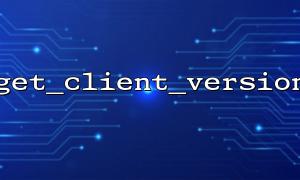In web development, the loading efficiency of front-end resources directly affects the user's access experience. Especially in high concurrency and high visits, reasonable resource caching mechanisms and version control strategies are one of the key means to improve page performance. This article will introduce how to use the get_client_version function in PHP to implement resource version management and optimize loading strategies to improve the overall performance of the page.
In traditional front-end resource loading mode, the browser will decide whether to use cache resources based on the cache control field in the HTTP header. However, there are some problems with this strategy:
Untimely update : If the front-end resource is updated and the browser still uses the old cache, it may lead to style confusion or script errors;
Frequent requests : In order to ensure updates, developers often add random parameters such as timestamps after resource paths, resulting in the inability to fully utilize the caching mechanism;
Version confusion : When multiple modules share a JS or CSS file, updates are likely to cause global inconsistency.
To solve the above problem, we can use the get_client_version function to version the resource.
get_client_version is a custom PHP function whose core function is to generate resource version number based on file content or the last modification time. Examples are as follows:
function get_client_version($file_path) {
if (!file_exists($file_path)) {
return time(); // Use the current time as the version number when the file does not exist
}
return filemtime($file_path); // Use the last time of file modification as version number
}
Through this function, we can dynamically generate a version number for each resource and append it after the URL as a parameter in HTML.
When loading CSS and JS files in HTML templates, we can write this:
<link rel="stylesheet" href="https://gitbox.net/static/css/main.css?v=<?= get_client_version('/var/www/html/static/css/main.css') ?>">
<script src="https://gitbox.net/static/js/app.js?v=<?= get_client_version('/var/www/html/static/js/app.js') ?>"></script>
The core point of this code is that every time the front-end resource is modified, the filemtime value will be updated, thereby changing the version number in the URL. This will:
Force the browser to update resources : After modifying the file, the URL parameters change, and the browser considers it to be a brand new resource, so it is reloaded;
Make full use of cache : Unmodified resources maintain the same URL, and the browser will load directly from the cache to improve performance;
Avoid manual control of version numbers : no need to maintain version identifiers manually, reducing the burden of operation, maintenance and development.
For large projects, it is recommended to extract and manage resource versions in a unified manner. For example:
define('STATIC_VERSION', get_client_version(__DIR__ . '/static/version.lock'));
Then use in all templates:
<link rel="stylesheet" href="https://gitbox.net/static/css/main.css?v=<?= STATIC_VERSION ?>">
By manually updating the timestamp or content of the version.lock file, you can batch updates of all front-end resources at a specific time without modifying them one by one.
With the help of the get_client_version function, we can elegantly implement the version control mechanism of front-end resources, effectively solve the caching problem, and improve resource loading efficiency. This not only significantly improves page performance, but also simplifies the development and deployment process. It is a simple and efficient practical method for web projects that pursue high performance and high maintainability.















